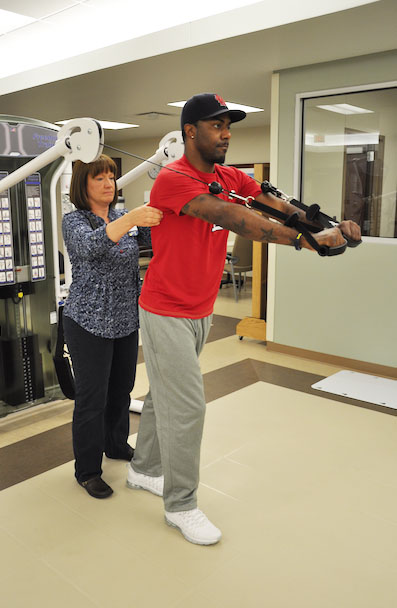
Overcoming Odds
By Madison Burke
Patient care tech Deontae Curtis is one of the faces of Boone Hospital. Staff love him for his hard-working spirit and dedication to the job. Patients love him for his overwhelming kindness and compassion. So when Deontae broke his neck last year playing football, there wasn’t a dry eye in the hospital.
Deontae was playing in his semi-professional football league in Peoria, Ill., when he dove for the football, landing just beyond the touchdown line. He caught the ball, but landed on his neck.
“I heard pops down my spine, and my ears started ringing. My whole body started tingling, and then I couldn’t feel anything or move,” says Deontae.
His teammates ran to him and talked about taking off his helmet to examine him. Fully awake, Deontae told them not to touch him and to call 911 because he hurt his spine.
“My doctors say if they would have moved me, I could have died because my spine was such a mess,” says Deontae.
Upon arriving at a local hospital, Deontae was told his C1, C4,and C5 vertebra had been fractured, leaving him paralyzed below the neck and in danger of suffocation. The C1 vertebra controls motor skills while C4 and C5 control the diaphragm and breathing.
“They told me I should have been dead,” says Deontae.
Deontae underwent immediate surgery to fuse the C4 and C5 vertebra with titanium plates.
“My doctor said repairing the C1 vertebra would be too risky, and he told me I’d never walk again. I told him the only way I’d never walk again was if he cut off my legs,” says Deontae.
When he awoke from the surgery, he found himself intubated with a tube down his throat and a ventilator assisting his breathing. He describes it as a sort of drowning feeling, and he became anxious. He then looked up at his vital signs, and when he saw that he was doing fine, he calmed himself down.
“I knew panicking would only make things worse. I would just check my vital signs from time to time to keep myself calm,” says Deontae.
When he was first taken off the ventilator he had some trouble breathing. At one point his heart rate began to climb, and his physician wanted him to be intubated again.
“I just concentrated for a few minutes and got my blood pressure back down. I really didn’t want to go back on the ventilator,” says Deontae.
Deontae quickly became known as the “captain of his own ship” by hospital staff for his ability to remain calm and overcome odds. This was reaffirmed when, just one day after surgery, he started getting movement back in his body.
“The first thing I could move was my right arm. It was really encouraging to get even that little bit of movement,” says Deontae.
The hospital wanted Deontae to stay there for at least 3 weeks before transferring to a rehab facility, but he was eager to get back to Missouri. After some negotiating, staff agreed to allow him to transfer to The Rehab Institute of St. Louis after one week.
“I only had movement in my arm when I first got there. I think I shocked everyone with what bad shape I was in,” he says.
Deontae says The Rehab Institute staff was puzzled by his initial test. He would have feeling in some areas and not in others. It didn’t fall into any sort of routine injury results.
“I think they realized pretty quick that I was going to be difficult to predict,” says Deontae.
And he certainly was. To everyone’s shock, Deontae got movement back in his legs within days and even began walking with the help of the therapists.
“I had my mind made up that I was going to be OK and I was going to walk again,” he says.
Deontae explains his initial paralysis was likely because of the incredible amount of swelling in his spine following his surgery. As the swelling went down, he got more movement back.
One of his favorite experiences at The Rehab Institute was participating in a wheelchair basketball game.
“I was already walking by then, but I still played. I got up at the end and started to push my chair out. That’s when a kid in the program came up to me and said he wished he could get up and push his chair out of there, too. I spent a while encouraging him to keep working at his therapy, and the next day I saw him taking steps. It was a great feeling,” says Deontae.
After just about 3 weeks in rehab, Deontae was able to return home to Columbia and follow up with Boone Hospital Center physical and occupational therapists. He worked with Boone’s occupational therapists to get the skills back that he needed to return to normal life.
“I couldn’t wait to get back to work, and they made sure I was going to be able to do everything I needed to do. I now have no limitations while doing my job. That’s a really good feeling,” says Deontae.
Deontae still works with the Boone Therapy outpatient physical therapists three times a week to get his strength and agility back.
“The therapists make you feel so comfortable and really inspire you to get better. I’m still building my strength back, and I know they will help me every step of the way,” says Deontae.
Deontae is back to working full time on the cardiology floor. His coworkers and patients say they are so glad to have him back.
“Everyone has been so great and supportive. I am so happy to be home at Boone,” says Deontae.